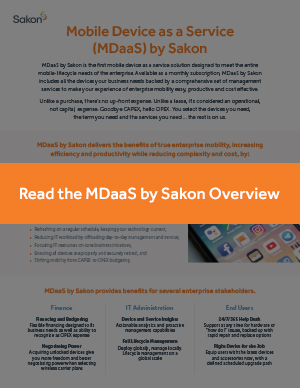The trajectory of enterprise mobility has been jaw-dropping. Twenty years ago – a lifetime ago, I know, but still our lifetime – wireless carriers were still struggling to get wireless data to work. Then came the revolution: the Blackberry, the iPhone, the smart phone, and the host of untethered, end-point computing devices we see today, shaking things up both as a consumer phenomenon and workplace paradigm.
And while the moment we live in is a distinctly mobile one, from an enterprise perspective let’s not mistake “omnipresence” for “managed.” In fact, the meteoric rise of mobility and its many permutations have left many enterprises perpetually playing catch up. Today’s enterprise mobility is a patchwork of programs, plans, and providers, and the only thing they have in common is their unpredictable (and high) cost, difficulty to orchestrate, and a demanding employee base that wants even more – better devices, better experiences, and better cradle-to-grave services – to keep them engaged and productive.
At Sakon, we’ve played an active role in the evolution of enterprise mobility, counting among our many accomplishments the development of 1) the first enterprise mobility management platform to support the adoption and management of iOS and Android devices and 2) the first platform to integrate all the necessary service components and providers to deliver a unified mobile experience to the enterprise.
I bring this up, because mobility and the management challenges it poses for the enterprise are not new. We have been helping enterprise clients provide their employees a seamless, rules-based “front-end” experience for ordering and provisioning mobile devices, as well as a proven back-office capability that combines exceptional inventory, carrier contract, and invoice management to ensure large enterprises pay the right amount for the right device for the right employee every time – automatically. And we’ve been doing so since the 2000s.
Problem solved, right? Hardly.
Go into any large enterprise today, and you’ll see that the mobility struggle is real. In part, because enterprise mobility isn’t homogeneous – it’s not just one thing. It’s many piece-parts all operating at the same time. On their own, each presents a management challenge, but together they’re more of a Rubik’s cube.
Welcome to the era of hybrid mobility.
Hybrid Mobility: The New Enterprise Landscape
As we talk with large-enterprise customers, partners and prospects around the world about their mobility needs, we hear a common set of pain points, from providing employees a compliant, user-friendly, self-service experience to enabling administrators to orchestrate best-of-breed providers to streamline the procurement of mobile devices, validate and pay bills, optimize plans, and negotiate with carriers in an intelligent, data-driven way. Each of these challenges has been compounded by the variety of mobility ownership models:
- Corporate Liable. This is the foundational model for enterprise mobility most familiar to companies and their employees. In this model, the enterprise owns the mobile device and assigns it to each employee (with employees of higher rank or in specialized roles getting different/better devices); IT supports it throughout its lifecycle, including problem resolution, retirement of the device and ordering and provisioning new ones. Plans, usage and payment are managed internally by the company.
Key challenges: Device cost, lifecycle management/administrative costs, carrier relations and negotiations, program optimization, and employee satisfaction.
- BYOD. While the first wave of iPhones entering the workforce began the “consumerization of IT” trend that we are still feeling today, bring-your-own-device-mania over the last decade has waxed, waned, and is now waxing again. We believe it’s here to stay, reflecting the pervasiveness of mobility (seemingly every employee can, and wants to, come to a new job with his or her own mobile device). And why argue with that? The enterprise loves the idea of not owning devices, greatly reducing its capital expenditures – but managing this heterogenous device horde is another matter.
Key challenges: Program administration, including stipend management/mobile reimbursements, security, and policy development and compliance.
- Mobile Device as a Service (MDaaS). Mobile Device as a Service (MDaaS) is an exciting development in enterprise mobility that shifts the CAPEX costs of mobile devices onto the balance sheet of a third-party financial institution and the mobility management responsibilities onto a third-party services provider, effectively transforming the expense of enterprise mobility from CAPEX to OPEX.
Key challenges: The risks that come with adopting a new business model; selecting the right solution partner(s); transparency.
While each of these ownership models presents unique challenges, hybrid mobility presents the enterprise the added challenge of managing them all at the same time, requiring a new, holistic approach.
Inaction Is Not an Option
Until now, most large enterprises have managed to muddle through mobility with sub-optimal tools, siloed methodologies, and, frankly, mediocre results. That has to change. With mobile devices proliferating (witness the variety of endpoint computing devices), prices rising (see $1,000+ iPhones), and data usage going through the roof (think mobile data as the growth engine of communications services, with some analysts projecting 7% data-cost growth annually), not managing enterprise mobility strategically is not an option.
We know, because the enterprise is telling us. A new client recently shared that it had been driven to act by a surprise $1 million in overages that year. The culprit? Employees upgrading their devices – charges not built into their budget forecast and which accumulated unchecked.
The kicker is, we hear a version of this story almost every day from a different company.
Which brings me to my final point. Managing enterprise mobility is complicated. It needs to be simple – and it can be. The solution will hinge on working with technology providers that 1) understands the pain points, 2) have experience solving problems and orchestrating services across the mobile lifecycle, from procurement and fulfillment through security, bill pay, and program optimization, and 3) have a sense, as Wayne Gretzky famously did, where the proverbial “puck” is going.
At Sakon, we know it’s going hybrid – and we’re helping our clients thrive there.
Watch this space.


